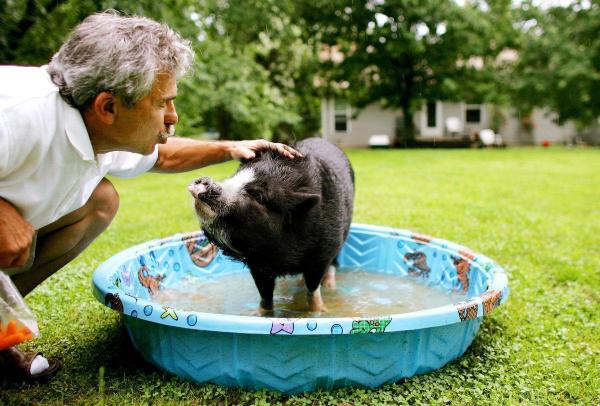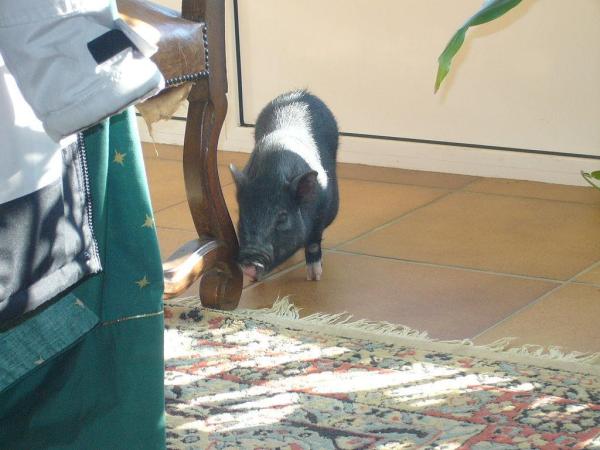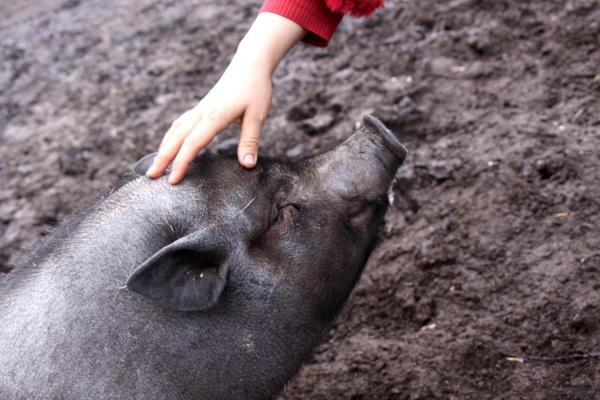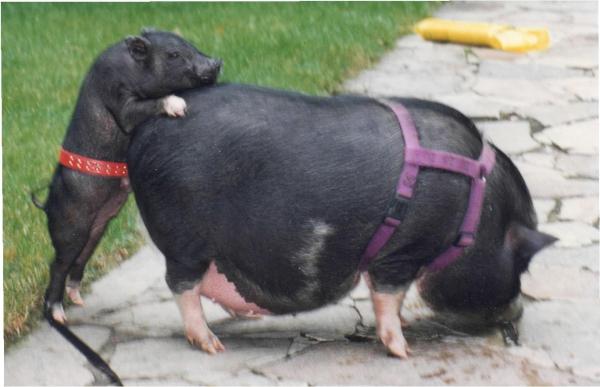Vietnamese Pot-Bellied Pigs as Pets


In large part thanks to viral videos of cute small pigs on the Internet, Vietnamese pot-bellied pigs have become a popular pet in recent years. At least they have become more popular than they were. Since they were not much available outside their native Vietnam, this increased popularity as a companion animal is exponential. Unfortunately, due to various factors, it has also raised problems. Not everyone is well-suited to keeping pigs as pets, others may have the temperament, but not the resources. There is also an often hidden issue which does not present itself until the pot-bellied pig reaches maturity.
At AnimalWised we look at Vietnamese pot-bellied pigs as pets. We look at their specific care needs, understanding their pens, diet, health, hygiene and other factors. In doing so, we can find out whether a Vietnamese pot-bellied pig is a good pet for you.
What is a Vietnamese pot-bellied pig?
As with dogs and cats, domestic pigs (Sus domesticus) have various breeds which can be found in variously-sized populations across the world. Although they are becoming more popular as pets, their initial reason for domestication was as a food source. The Vietnamese pot-bellied pig is a domestic pig breed common in Vietnam where it is known as the Lon I pig or I pig (Lợn Ỉ in Vietnamese).
The Vietnamese pot-bellied pig is a small pig breed with males weighing an average of 110 lb with females being marginally smaller at 105 lb. They are short in stature measuring about 14' in height. This small size has led them to be referred to as miniature pigs, mini pigs or even teacup pigs, but this are misnomers. They are not micro-pigs and will take up a lot of space in the home.
The Vietnamese pot-bellied pig has black hair all over its body, usually thickest along the line of their back. However, due to domestic breeding it is posible to see them white with black spots. They are very intelligent animals which we first brought to North America in the 1980s[1]. They were first kept as animals in a petting zoo, something their docile demeanor favored. They can develop bonds with humans and are even able to be litter-trained.
Their name derives from the fact they often have a sagging belly underneath them. This can often sway as they walk and brush against the ground.
Below we look at the different care needs of the Vietnamese pot-bellied pig.
Housing for a Vietnamese pot-bellied pig
As with any other pet, they will need their own area in which they can live, sleep and eat. This personal space must be their own and allow them to build security. Ideally, they should have a pasture to walk around in outdoors. For some, this is not possible and will lead them to ask can I keep a Vietnamese pot-bellied pig indoors? The answer is yes, but only if you have enough space.
While a baby piglet will need less space, as they mature, they will start to take over a home. Adult Vietnamese pot-bellied pigs will need a pen with at least 2 square meters of space. This should be sufficient enough to let them lie down and trun around with a separate area for their litter (if trained). The pig should be kept in the pen for as little time as possible, but may be necessary to keep them overnight.
For the greater part of the day, they should be allowed space to wander as freely as possible. This means they should have their own room or rooms if kept indoors. Depending on your home, there are two options you can have when keeping a Vietnamese pot-bellied pig as a pet:
- Indoor room: you can keep a Vietnamese pot-bellied pig indoors if you have enough space for them. They will require access to their own room in which they can walk around freely. The more space the better, meaning they are not ideal for apartments. The area also needs a non-slip floor so their trotters won't slide around.
- Outdoors: if you have outdoor space you can create a paddock or enclosure which will need to have a shelter available. This is especially important in the winter as they should not be exposed to very cold temperatures.
It is very important all hazards are removed from the area. They should not be able to ingest anything they shouldn't and exposed wires need to be removed to prevent them chewing on them. They will also need a comfortable bed on which they can sleep. This can be straw if kept outdoors, but they may need a mattress for indoors.
Pig mobility in the home
When the Vietnamese pot-bellied pig is younger, they will be more mobile. They may be able to walk upstairs and navigate various environments. As they mature, their weight increases to an extent their mobility is restricted. This means you will have to have elements which can facilitate their movements indoors and outdoors when needed. For example, they may need a ramp when entering the back door.
Since these miniature pigs are very intelligent, it is possible they will try to escape. You will need to ensure they have fencing which is strong and that garbage is kept locked up. This is because their intelligence is matched only by their appetite.

What to feed a Vietnamese pot-bellied pig
Vietnamese pot-bellied pigs are omnivores, meaning they can get their nutrition from a range of foods. However, this does not mean they can survive on substituting dog food or cat food. As with these animals, they will need to be given a feed formulated especially for their porcine needs. You can buy Vietnamese pot-bellied pig-specific feed, but it may not be available in your local pet store. This means you might have to buy online in advance.
As with providing a place for them to sleep, you will need to provide an area set aside for them to eat. Use large deep bowls made from metal. Plastic or ceramic dishes can be too easily broken. You will also need to ensure each pig in your home is fed separately. Pigs can be greedy and more dominant animals will likely steal food of others.
How much to feed a Vietnamese pot-bellied pig
The amount of food you give your miniature pig will depend on their size and the brand of feed. Each manufacturer should print appropriate guidelines on the packaging. Generally, you should feed the pig about 2% of their body weight in food per day. This is total food, the majority of which should be their dry feed.
Pigs should be given food in small portions throughout the day. This should be at least 3 to 4 times a day, but more would be ideal. Never leave all of their food out at once. Pot-bellied pigs are greedy and will overeat. If they are given too much food, they can easily become obese and develop various health problems.
In addition to their dry commercial feed, you can feed them other foods as treats or to boost their nutrition. Foods you can give to Vietnamese pot-bellied pigs include:
- Unsalted nuts
- Celery
- Zucchini
- Lettuce
- Apples
- Pears
- Cabbage
- Squash
- Grapes
- Pumpkin
- Sweet potato
Fruit should be moderated more than vegetables since they have high sugar content. We should not give any food which has been prepared with salt, artificial additives, preservatives or other flavorings. In general you should stay away from:
- No additives: you should not feed your pig food which has any added salt, sugar or other ingredients which can weaken their health. This means we need to stay away form processed or canned foods and only provide additive-free fresh food.
- No farm feed: the pig feed used in farms is designed to increase the pig's weight as much as possible. If we give this to a pot-bellied pig we keep as a pet, it will cause obesity and health problems.
- Pitted fruit: if you feed fruits to your pig which have large stones, it can cause a choking hazard. The same applies for shells on nuts.
- Cereals: generally pigs do not need a lot of carbohydrates. While it is fine if they eat small amounts, if they have a lot of cereals or grains in their diet it will cause them harm in the long-run.
Litter training Vietnamese pot-bellied pigs
As we have mentioned above, it is possible to train a Vietnamese pot-bellied pig to use a litter box. While this litter b ox will need to be bigger than that of a cat, the process is similar. You can take them outside to go by leashing them in a harness and using command words. Repeat these steps and they should be able to learn how to go outside.
You can train a pot-bellied pig to use a litter tray or a specific area to urinate and defecate. Since there are not widely-available pig litter boxes, you will have to improvise with another type of container such as a storage chest with the lid taken off. Do not use actual cat litter. Pine shavings are ideal, but do not use cedar shavings or other types of wood which can cause agitation. Newspaper will do in a pinch.
Exercise and fun
Although pigs are often unfairly labelled as lazy, they require exercise to stay healthy and prevent obesity. As stated above, this means they will need to have enough space to move around. You will also need ways to encourage exercise. One good idea is to fill a paddling pool with water and allow the pig to splash around in it. It is also a good way to help them stay cool in summer.
Dogs are not the only animal which enjoys playing with toys. In fact, it is possible for a pig to understand the concept of fetch. Even if they don't retrieve a ball, it can be good to throw it around for them and let them interact.

Vietnamese pot-bellied pig education
For the Vietnamese pot-bellied pig to live happily as a pet, they will need to understand some basic rules. As their caregiver, it is up to you to ensure they understand these rules through proper training. As with dogs, pigs have a pack social structure. They are orientated toward a leader figure which must be you in the domestic environment.
Pigs can live in a home with other pets and animals, but they will need to be sufficiently socialized. This is best carried out when they are young, although it is possible an adult pot-bellied pig can be socialized. Never hit or mistreat your pot-bellied pig. Only use positive reinforcement and reward good behavior rather than punish bad. Treats in the form of fresh fruit and nuts can be used as incentives.
Walking a Vietnamese pot-bellied pig
As with dogs, it is possible to take your pot-bellied pig for a walk. As with these other animals, you will need to keep them restrained with a harness. You cannot use a collar and a leash as the pig doesn't not have a neck which will allow this. Instead the harness needs to support them under the front legs.
The earlier you take the pig out for walks, the better. They will need to get used to the outdoor environments and we will need to always check to ensure they are well. Essentially, you will need to carry out the same precautions and clean up after the pig as you would walking a dog. Some may not adjust well to going for walks, but most will.

Can I keep a Vietnamese pot-bellied pig as a pet?
As you can see, there are a lot of things to consider if you want to keep Vietnamese pot-bellied pigs as pets. One thing we haven't mentioned is that it is important they are neutered when appropriate. Not only will this prevent certain health problems such as mastitis and cancer, it will greatly reduce behavioral problems. Once the pigs reach sexual maturity, they can become aggressive and try to find a mate. This means it also helps avoid escape.
It can be difficult to treat health problems in Vietnamese pot-bellied pigs due to a lack of training among veterinarians. As it is a rare animal to have as a pet, you will need to find a specialized veterinarian. This may be someone who has experience working with farm animals.
Finally, it is important to note that there are unscrupulous pig breeders and dealers who will try to sell piglets as miniatures. In reality, they are a different breed which can grow up to be hundreds of pounds in weight. They may starve the pigs they have for show so they appear smaller or show parents which have not yet fully developed.
We need to be careful and ensure we don't abandon the pig just because they are not the diminutive size we expected. You really need to be sure you are prepared for the pig to live with you for a long time as Vietnamese pot-bellied pigs can live up to 20 years of age. If you don't have space, have an unstable home environment or simply can't commit to that length of time, then you should consider a different pet.
For those who do meet the criteria, keeping a Vietnamese pot-bellied pig as a pet can be an life-enriching experience.
To learn more about pigs in general, take a look at our related articles on the intelligence of pigs and whether pigs sweat.
If you want to read similar articles to Vietnamese Pot-Bellied Pigs as Pets, we recommend you visit our Basic care category.
1. Garr, R. (1998). Connell Flyer 2. Retrieved from:
https://petpigs.com/education/farec-forgotten-angels-rescue-education-center/history-of-the-potbellied-pig/connell-flyer-2/








